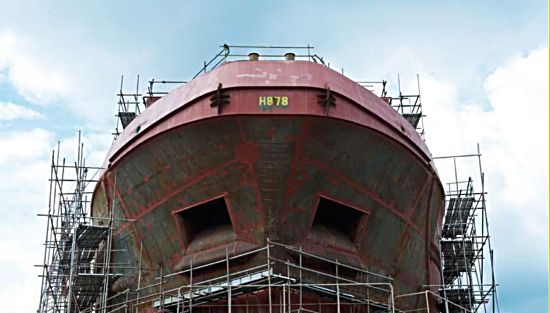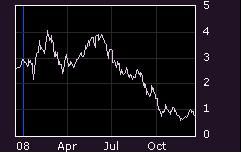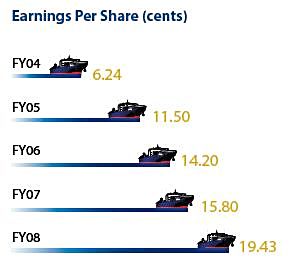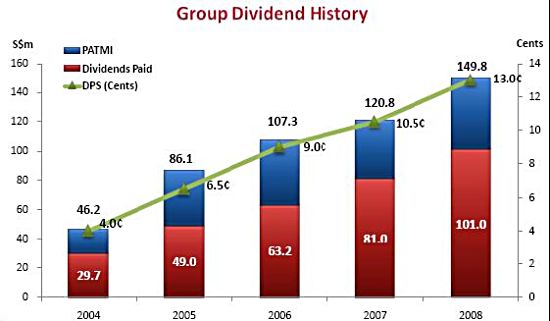

SURPRISE! SURPRISE! How long I haven’t look at Jaya share price? Two days, three days or one week? It closed at $0.28 recently. How I wish, my fingers were not itchy and keyed in the “buy” button about one month back.
What happened? I don’t know, perhaps the market is telling me that Jaya has a big hole at the bottom of its hull and it is no longer capable of sailing anymore.
The first reason that comes to mind for the sinking share price is that Jaya reported a slump of 78% in NPAT to $9.1 million from $42.2 million in 1Q 2009. But is it that bad? Of course not.
In fact, 1Q2009 was a beautiful quarter if you take away an unrealised loss on derivative financial instruments and foreign exchange loss totalling $37.2 million.
It was beautiful because Jaya earned a gross profit margin of about 55% for both its chartering and shipbuilding business.
Look around other listed OSV companies, even some pure charterers are not getting that kind of margin. I know it is unsustainable. But when the margin drops, who will be hurt more?
Those with GP margin of 20-30% or Jaya and CH Offshore with a margin of 50-70%?
While many factors must be taken into consideration, the chances are, if a shipwreck happens, Jaya and CH Offshore will be the last one standing.
I don’t like to compare Jaya to CH Offshore as a big portion of Jaya’s earnings are not reflected in their gross profit because some of the vessels they build each year are not for sale immediately.
It is captured in ‘other income’ when they are sold later while CH Offshore’s gross profit is all about chartering vessels and ‘other income’ is gain from trading of vessels.
As for balance sheet, whose is more conservative? One that capitalises its vessels at cost or one that capitalises vessels at market price?
Talking about cashflow, liabilities, credit crunch and future sale of vessel …. Other than $248 million in debts, $58 million for FY2008 final dividend payment (paid) and another $250 million in liabilities and some insignificant lease commitment, there won’t be any surprise coming out of Jaya as it has never engaged in sale-and-leasebacks.
Jaya owns its vessels and shipyards. Better still, the management has indicated in their latest results that they intend to sell more vessels rather than hold them for chartering.

Strong cashflow coming
I like that as it is sensible and the best is if the price of everything is so good, then sell every vessel away, take the cash and wait or return them to shareholder.
Unless there is a coming shipwreck as what is happening in bulk shipping, which I think is unlikely, Jaya will generate very strong cashflow (include cashflow from disposal of vessels) with the cooling down of shipbuilding program, (cash will pour in with the reduction of capital required) which hurt its cashflow quite a bit in 1Q2009.
It generated $14.5 million from operating activities and $32 million from disposal as compared with $15.7 million from operating activities and $60 million from disposal in 1Q2008 (Jaya’s disposal of vessels in 1Q2008 was huge).
Here is the meat - Jaya reported $9.1 million NPAT for 1Q2009 but $46.6 million of cash poured into Jaya bank before talking about capex which was $56 million.And I have not a single worry about the unrealised loss on derivative financial instrument due to unfavourable exchange movement. It is not what is reported in the P&L that matters but the nature or reason the derivative is used.
While it is not a prefect hedge, the reason for these losses is actually that Jaya want to be conservative, to be certain of its cashflow. Oh, getting killed for the reason they are trying to avoid?
Foreign transaction is another story as some of the losses may be real due to unfavourable exchange movement, especially on loans, receivables, deposit and cash remittance for dividend payment. But that will not wreck Jaya. Sinking oil prices will delay expenditure in offshore activities with Keppel Corp being the latest one to get hurt.

My view is unchanged regardless of whether oil price is at US$50 or US$150 and I think it is very funny that International Energy Agency (IEA) recently urged oil companies/OPEC to continue their expenditure despite the drop of US$100 in oil price.
What IEA is talking about is the same as what I have in mind. By celebrating or cheering a steep drop in oil price, with many expenditures being delayed or thrown away, we are seeding for another sharp surge in oil price in the future.
There is no need to do a valuation of Jaya on the basis of PE, Price/Book, ROE or dividend yields as anyone of these valuation methods will give the same results. It is just a plain no-brainer. Jaya will generate more cash than its market capitalisation within a couple of years. So keep showing me the cash!
This article was first published on the writer’s blog and has been adapted for publication here with the kind permission of the author, a 30-year-old retail investor.







